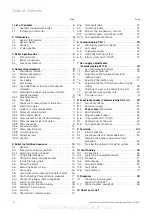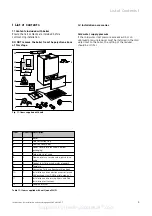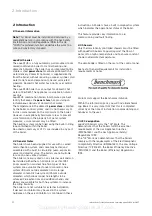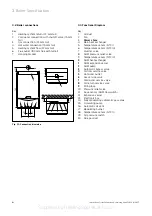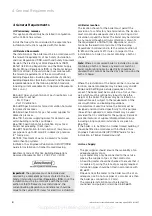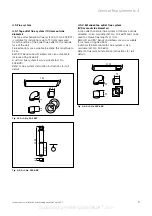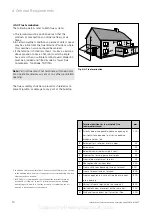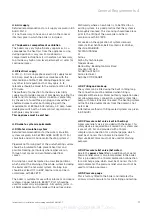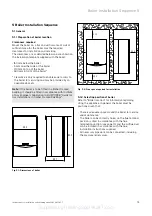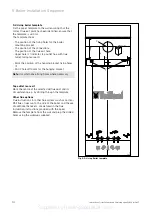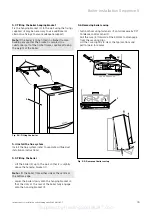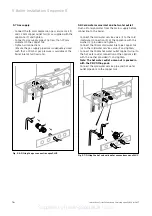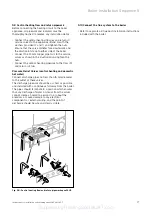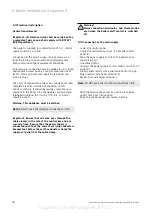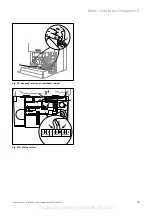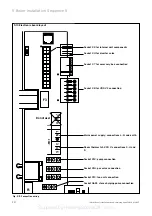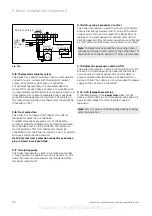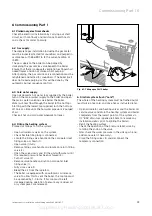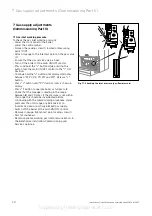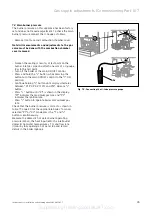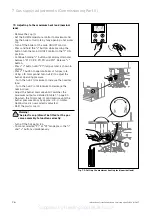
General Requirements 4
Instructions for installation and servicing aquaPLUS VUI 362-7
11
4.6 Air supply
Detailed recommendations for air supply are given in BS
5440: Part 2.
It is not necessary to have an air vent in the room or
internal space in which the boiler is installed.
4.7 Cupboard or compartment ventilation
The boilers are very high efficiency appliances. As a
consequence the heat loss from the appliance casing
during operation is very low. For cupboard or
compartment installations it is therefore not necessary
to provide any high or low level permanent air vents for
cooling purposes.
4.8 Electrical supply
A 230 V, ~ 50 Hz single phase electricity supply fused
to 3 Amp. must be provided in accordance with the
latest edition of BS7671 (IEE Wiring Regulations) and
any other local regulations that may apply. In IE,
reference should be made to the current edition of the
ETCI rules.
The method of connection to the mains electricity
supply must provide a means of completely isolating the
boiler and its ancillary controls. Isolation is preferably
by the use of a fused three pin plug and unswitched
shuttered socket outlet, both complying with the
requirements of BS 1363. Alternatively, a 3 Amp. fused
doublepole switch with a 3 mm contact separation on
both poles may be used.
This appliance must be earthed.
4.9 Guide to system requirements
4.9.1 Water circulation system
Detailed recommendations for the water circulation
system are given in BS 6798 and BS 5449: Part 1 (for
small bore and micro bore central heating systems).
Pipework not forming part of the useful heating surface
should be insulated to help prevent heat loss and
possible freezing, particularly where pipes are run
through roof spaces and ventilated underfloor
spaces.
Draining taps must be located in accessible positions
which permit the draining of the whole system including
the boiler and the hot water system. Draining taps
should be at least 1/2 in. BSP nominal size and be in
accordance with BS 2879.
The boiler is suitable for use with minibore or microbore
systems. Copper tubing to BS 2871: Part 1 should be
used for water carrying pipework. All capillary joints in
all DHW pipework must be made with lead free solder.
Particularly where a new boiler is to be fitted to an
existing system, it is good practice that the system is
thoroughly cleansed. This cleansing should take place
prior to the fitting of the new boiler and be in
accordance with BS 7593.
For advice on the application of system cleansers
contact either Sentinel, Betz Dearborn Ltd. Widnes,
Cheshire, WA8 8UD.
Tel: 0151 495 1861
or:
Fernox
Alpha-Fry Technologies
Tandem House
Marlow Way, Beddington Farm Road
Croydon CRO 4xS
Tel. 0870 601 5000
Fernox technical
help line 01799 550811
4.9.2 Filling and make up
The system can be filled using the built in filling loop.
The connection must be removed when filling is
completed. Where local Water Authority regulation does
not allow temporary connection, a sealed system filler
pump with break tank must be used. The heating system
will not be filled automatically from the domestic hot
water side.
(Alternative methods of filling sealed systems are given
in BS 5449).
4.9.3 Pressure relief valve (central heating)
A pressure relief valve is provided with the boiler. This
safety device is required on all sealed C.H. systems and
is preset at 3 bar and provided with a 15 mm
compression connection for a discharge pipe, which
must be of no less than 15 mm in diameter. The
Pressure Relief Valve must not be used for draining
purposes.
4.9.4 Pressure relief valve (hot water)
Due to the
power store
fitted an additional hot water
pressure relief valve is also incorporated in the boiler.
This is provided with a 15 mm compression connection
for a discharge pipe, which must be of no less than 15
mm in diameter. The pressure relief valve must not be
used for draining purposes.
4.9.5 Pressure gauge
This is factory fitted to the boiler and indicates the
primary circuit pressure to facilitate filling and testing.
Supplied by HeatingSpares247.com


